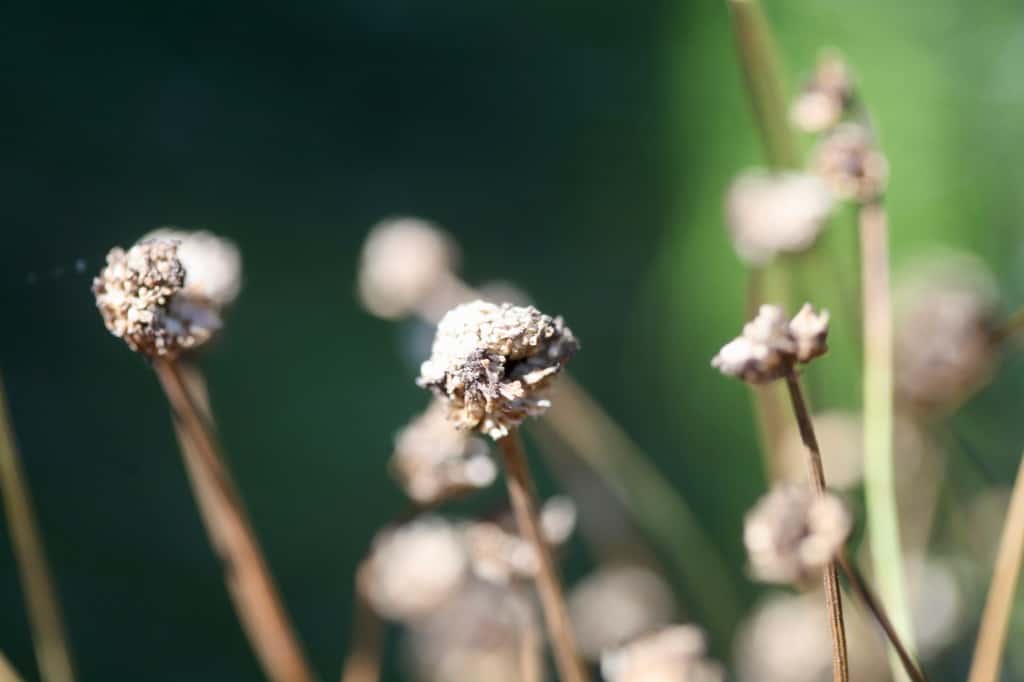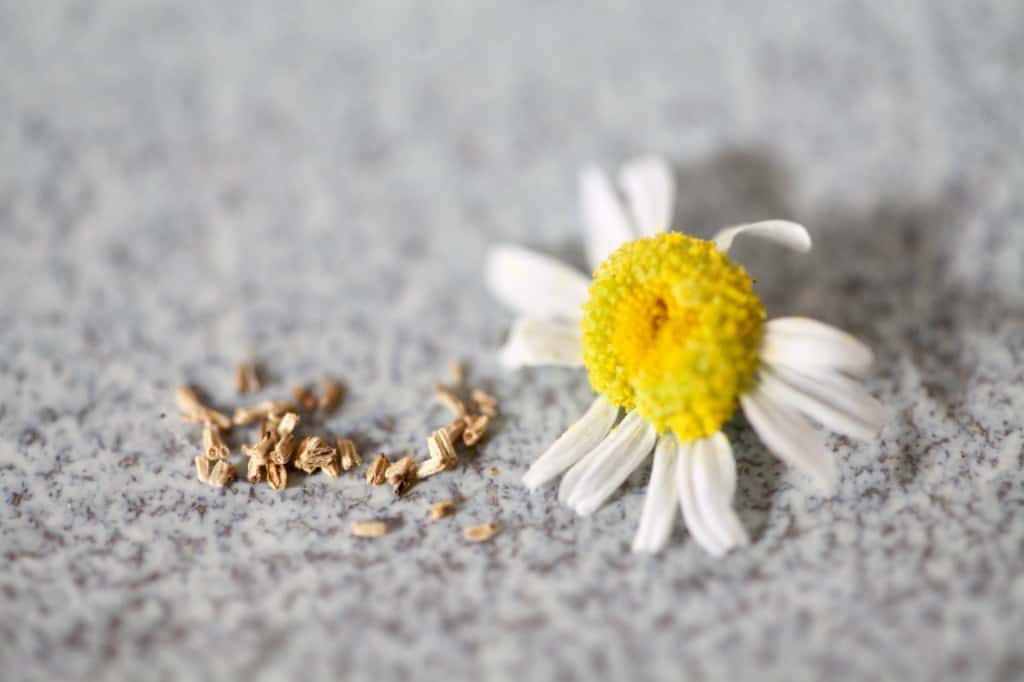Saving chamomile seeds from the garden is easy, as long as you catch the tiny seeds before they disperse back into the garden all on their own. Learn how to harvest chamomile seeds, and save your homegrown seeds for the next planting season.

Chamomile is an annual herb that readily reseeds itself from one year to the next. Some of these self sown seeds will likely germinate the following season.
They will grow as long as their needs for growth are being met where they land in the garden. Chamomile seeds will grow well in fertile well-drained soil, in a full sun location.
By harvesting your own chamomile seeds, you will have some control over the planting location. You can then designate an area in the garden for your chamomile plants.
If you are planning to harvest chamomile seeds to plant in the herb garden next season, it's important to know the right time in which to harvest the seeds.
Always allow the seeds to mature on the plant. However, make sure to catch the plants before they disperse the seeds back into the garden.

Benefits Of Harvesting Chamomile Seeds
- Growing chamomile from seed is very easy, and growing from your own seed is a cost effective and satisfying endeavour.
- Harvesting your own seed also helps you to grow plants that are more suited to your growing location, as the plants will adapt to your growing area over time.
- Harvesting your own chamomile seeds allows you to have more chamomile growing in your garden from year to year, for free.
- There are a number of popular types of chamomile to grow, including German chamomile, or matricaria chamomilla and matricaria recutita, as well as Roman chamomile, or chamaemelum nobile.

- You may even be growing wild chamomile, or pineappleweed, and can save the seeds from these plants as well.

- German chamomile is an annual plant, so harvesting seed to be replaced from year to year just makes so much sense economically.
- Roman chamomile is a low-growing perennial also known as Russian chamomile. This plant is most often used as a ground cover.
- Saving these seeds will help you to increase and propagate your stock of this plant.

Chamomile is a wonderful herb to grow, for many different reasons. Saving the seeds will allow you to have chamomile growing in your garden, to use for it's many benefits.
Benefits Of Chamomile
- The chamomile plant is a beneficial herb from the asteraceae family, which is often used in herbal remedies, and for it's medicinal properties.
- Chamomile plants are also great companion plants in the vegetable garden, as well as in the flower bed.
- The edible blooms of the chamomile flowers and the tender plant leaves also have culinary uses. Many people use chamomile as a soothing relaxing tea.

Where Are The Seeds In Chamomile?
The seeds on the chamomile flower are located within the central disc of the flower, right under the disc florets.
These center florets are normally yellow in color when the flowers are in full bloom.
After pollination, tiny seeds will begin to form under the central florets.
As the seeds grow and mature in each flower, the centre discs begin to age and turn brown.
When the seeds are mature and ready to harvest, they will dry and easily fall away from the central disc for dispersement. With just a bit of pressure placed against the center disc, the seeds and chaff will fall away from the flower.
The key is to catch the seeds and to harvest them, before they are released on their own, into the garden.

What Do Chamomile Seeds Look Like?
Chamomile seeds are very tiny to the naked eye.

The seeds are tubular in shape, tan in color, and measure approximately 1 mm in length.
When sorting the chamomile seeds, it's often helpful to have a magnifying glass available. A close up view will help to readily distinguish the seeds from the chaff.
With a closer look at the situation, you will be able to identify the seeds and separate them from the chaff.

When To Harvest Chamomile Seeds
Harvest chamomile seeds at maturity, when the center discs of the flowers have turned brown and dry, and the seeds easily fall away from the flower.

For an in-depth look at chamomile seed development in German chamomile, have a look at this article in nature.com.
Now let's have a simplified look at this process of floral and seed development, and learn how to identify when the seeds are mature:
Seed Development
The Flowering Period
Chamomile flowers will grow from seed to bloom very quickly. Within two months of planting we had blooms forming on our chamomile plants.
Once the plants begin to bloom, the tiny chamomile flowers will open. The white daisy-like flowers first open with the white petals facing forward. As the blooms open, the white ray petals become horizontal to the stem.

At this point the flowers can be harvested for drying, if you are harvesting and drying chamomile for tea.
If you want to harvest chamomile seeds, it will be important to leave some flowers in place for pollination and seed formation.
Leaving some flowers on the plant will allow them to become pollinated, and then start to form seeds.
Once the plant starts to develop seeds, energy is diverted away from blooming.
The energy will go into the seed making, rather than flower production. In this case, you will likely notice less blooms on your chamomile plants.
If you are growing chamomile to dry and harvest the flowers, it can be helpful to set a few plants aside just for seed production only. That way it will not interfere with bloom production on the remaining plants.

Pollination
If the chamomile flower heads are not harvested, they may become pollinated, resulting in the formation of seeds.
If the flowers remain on the plant, they will begin to age, and the seeds begin to mature.
The white outer flower petals, or ray florets, will move to a backwards facing position, pointing towards the stem of the plant.

The disc florets, which are the yellow centers in the fresh flowers when in full bloom, begin to turn brown.
This process can occur fairly quickly, resulting in mature seed formation within 15 to 17 days.

Seed Maturity
As the centre discs of the disc florets turn brown, they become dry and brittle.
When the florets and seeds fall away from the disc with a gentle touch, the seeds are fully mature and ready to be harvested.

Chamomile seeds are self dispersing. It's important to catch them when they are ripe.
If you wait too long to harvest the seeds, the elements such as wind and rain can contribute to aiding in their release from the flower. You may still catch some seeds, however can also lose a few to the garden.
In your patch of chamomile you will likely have many different flower stems presenting with flowers of different stages of maturity, and therefore will also have seed pods of different ages of maturity.
Keep this in mind for when it is time to harvest the seeds. Not all seed heads will mature at the same time.

How To Harvest Chamomile Seeds
Harvest Regularly
Because your chamomile plant will have flowers in different stages of maturity, you will find that the mature seed heads will be ready to harvest at different times.
If you are planning to harvest some seeds, keep an eye on your plants, and check on them regularly to determine if any seed heads are ready for harvesting.
That way you can catch them before they release the seeds into the garden.

Harvest From The Garden
- Harvest the chamomile seed heads on a dry day, after the morning dew has evaporated from the plants.
- Use a pair of clean scissors or snips for harvesting.
- Bring a bowl or basket with you to gather the seed heads.
- For a quick harvest, cut the stems with multiple mature seed heads attached. Some chamomile varieties will have multiple flower heads on one stem, while others will have only one flower head per stem.
- Multiple seed heads are found on stems of German chamomile, which produce multiple flowers on branching stems. Roman chamomile plants produce flowers on a single stem, therefore more stems will need to be harvested for more seed heads.
- Bring the harvested seed heads inside to process, and to remove the seeds from the seed heads.

Process The Seeds
- It is very easy to remove mature chamomile seeds from the seed heads.
- Hold the brown and mature chamomile seed head over a bowl to collect the contents.
- Take your finger and brush it against the seed head, causing the contents to separate from the base, and fall into the bowl.
- The contents will include seeds and chaff.
- The seeds can be easily identified from the chaff by their appearance, however remember that they are very tiny.
- Using a magnifying glass I identify and pick the tiny seeds out of the chaff with a pair of tweezers. It's the only way I have found to identify and separate the seeds with ease.
- Set the seeds aside on a plate or in a clean bowl, allowing them to dry for several days before storing.



How To Store Chamomile Seeds
- Store the chamomile seeds in a paper envelope, which will help to keep them dry.
- Label the envelope with the storage date, and the type of seed contained.
- For best results, store in a cool, dry, and dark place, until they are ready for planting out the next growing season.

Conclusion
Saving your own chamomile seeds is a cost effective way to grow chamomile in your garden, year after year.

If you have saved some seed from your own garden in late summer, next year you will be a step ahead of the game by having the seeds on hand.
The seeds are easy to harvest and store.
Make sure to check on your plants regularly if you are allowing some flowers to go to seed.
The seed heads should remain on the plants until mature, and harvested before they disperse the seeds into the garden.
Harvesting your own seeds will allow you to have seeds that are adapted to your own environment over time. It's a great way to grow sustainable plants for the garden.
Just imagine growing your own fresh chamomile flowers from your own seed, then drying those chamomile blossoms to make your own herbal tea.
Impressive indeed.

Have you ever harvested chamomile seeds from your garden? Be sure to leave a comment below to share your experience!
Other Posts You May Like:
See the Web Story on Harvesting Chamomile Seeds!
PIN IT FOR LATER!










Leave a Reply